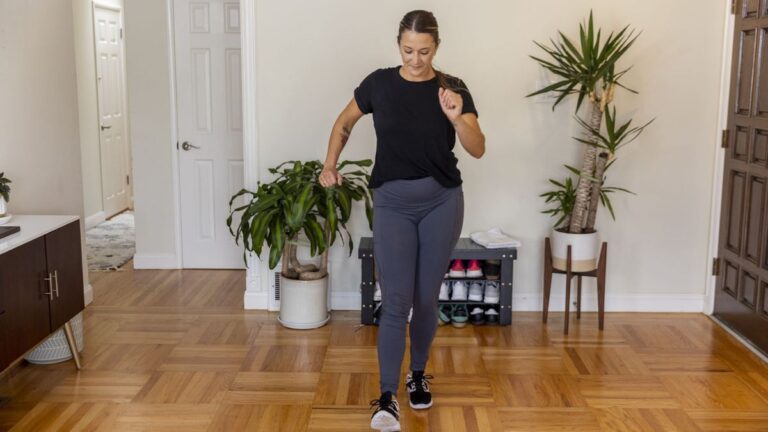Boost Your Daily Walk with This Simple Adjustment
Elevate Your Daily Walk with One Simple Trick
Walking is one of those activities that feels almost effortless—like hitting the reset button on your day. But what if we told you that a tiny adjustment could maximize the benefits of what is already an elegant, uncomplicated exercise? You might be thinking, “Really? Just one tweak?” Yes! This article dives into how even the simplest change can transform your daily stroll into a power-packed workout. Grab your sneakers and let’s dive in!
Why Walking Matters
Let’s take a moment to appreciate what walking does for us. Have you ever finished a walk feeling lighter in both body and mind? That’s not just a coincidence. Walking improves cardiovascular health, helps burn calories, boosts mood, and may even fight off chronic diseases. It’s an activity that’s free and accessible. But what if you could make it even better?
The Power of Posture
It turns out, a lot depends on how you carry yourself while walking. Imagine you’re holding a delightful cup of coffee—how would you walk? You wouldn’t let the cup spill, right? You’d have a sense of poise. The same idea applies to your posture as you walk.
Stand Tall
When most people walk, they might slump their shoulders or stare down at the ground—it’s all too common. Straightening up isn’t just about aesthetics; it’s about biomechanics. Good posture allows your body to function as it’s meant to, minimizing strain and maximizing performance. Here are some quick tips to achieve that perfect walking posture:
- Align Your Ears, Shoulders, and Hips: Imagine a string pulling you up from the top of your head.
- Relax Your Shoulders: Keep them down and back; no need to hunch forward.
- Engage Your Core: A tight core supports your spine and can be your best friend.
Now, as you visualize yourself walking tall, think of how a majestic tree stands—firm and unyielding—but also flexible enough to sway with the wind. This kind of posture will make your walks more efficient and enjoyable.
Embrace the Arm Swing
You might not have considered your arms much while walking. I mean, they’re just hanging there, right? Actually, they play a huge role! Think of your arms as the counterbalance to your legs. When you swing your arms naturally at your sides, they kickstart momentum, powerful enough to give your legs a boost without extra effort.
Find Your Natural Rhythm
To get the most from your arm movements while walking:
- Keep Elbows at a 90-Degree Angle: This allows for a full swing.
- Let Your Arms Swing: Don’t keep them rigid. Movement should be fluid and natural.
- Coordination is Key: As your left leg steps forward, your right arm should swing forward and vice versa.
Weaving in this arm motion not only serves to aid in boosting your rhythm but also enhances your speed, which means you’re burning additional calories without feeling like you’re running a marathon. Talk about a win-win, right?
Walk on Varied Surfaces
Think about the variety in life—wouldn’t it be dull if everything stayed the same? The same goes for your walking routine! Walking on different surfaces engages various muscle groups and angels, giving you a more comprehensive workout.
Mix It Up
- Grass: Offers cushioning and challenges your balance.
- Sand: Provides resistance, which can be a mini-workout.
- Concrete: A bit harsh, but good for tapping into that core strength.
Switching up your walking surfaces mimics the unpredictable nature of life while delivering a workout that keeps your muscles guessing. Flexibility is essential—not just in your schedule, but in your walking routine, too!
Mind Your Breath
Have you noticed how we often forget to breathe deeply? Coming up for air is essential, especially during exercise. Staggering your breath will help maintain endurance and even keep your heart rate in check.
Breathing Techniques
- Inhale Through Your Nose: This allows for a deeper breath and intake of oxygen.
- Exhale Through Your Mouth: Controlled exhalation helps expel more carbon dioxide.
- Count Your Steps: Try a count of 2-3 steps for each inhale, and 2-3 steps for each exhale.
Imagine you’re a gusty breeze—to be effective and refreshing, you need to flow easily and rhythmically. Breathe in fresh energy, and breathe out any fatigue.
Add a Purpose
Walking back and forth can sometimes feel monotonous. To keep your daily trek engaging and purposeful, why not weave in a specific goal? Setting intentions can rev up your motivation!
Purposeful Walking Ideas
- Track it: Use a fitness tracker or app to log your walks, aiming for daily goals.
- Listen Up: Enjoy your favorite podcast or an audiobook.
- Engage a Friend: Partner with a buddy to motivate each other.
Having a purpose transforms a regular walk into a goal-oriented mission. Infusing fun and creativity can amplify the walking experience significantly.
Conclusion
Walking is a beautiful, uncomplicated form of exercise—but it doesn’t have to be mundane. With small adjustments like improving posture, coordinating your arm swing, changing up surfaces, minding your breath, and walking with purpose, you can heighten your walks into a fulfilling and powerful workout. So, lace up those shoes and hit the ground running (or strolling)!
FAQs
-
How long should I walk each day to see benefits?
- Aim for at least 30 minutes daily. Shorter walks can be beneficial too; the key is consistency.
-
Is walking better than running?
- It depends on your goals. Walking is easier on the joints and can be just as effective for maintaining overall health.
-
Can I walk indoors?
- Absolutely! Walking at home or on a treadmill can still offer you excellent health benefits.
-
What type of shoes are best for walking?
- Look for comfortable, supportive shoes with good cushioning that fit well.
-
How can I stay motivated to walk regularly?
- Set goals, track your progress, vary your routes, and mix in music or podcasts for a more enjoyable experience!







